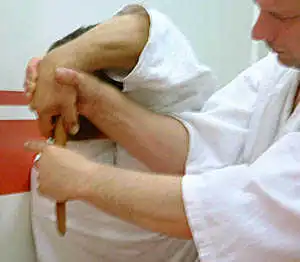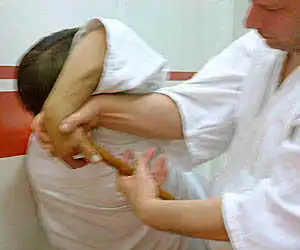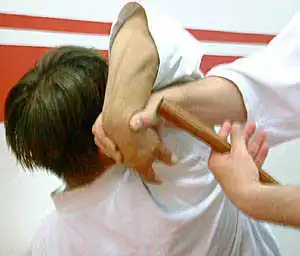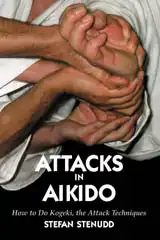Shihonage in Tantodori TsukiShihonage against several different tantodori attacks. Many more aikido videos on my YouTube Channel. The Aikido Technique Shihonage on Tsuki Knife AttackWhen taking the knife from the attacker in the shihonage technique, there are two ways to go about it — either before uke is thrown or after. The latter is rather complicated, the way I would do it, involving a lot of spinning around for uke, a tricky change of grip for tori, et cetera. The former, on the other hand, must be done with great care to firstly control uke in a position where uke's balance is just about zero. Here is the former version, done before uke is thrown. Make sure that uke is out of balance, body bent back in an arch, up on toes is fine too. Your grip on uke's knife hand should initially be two-handed, as seen on the picture above. Your position should be by uke's side, and your shihonage grip should be such that you do not allow uke to turn toward you. I would say that if uke still manages to turn, you will have to make the throw, and then take the knife. Watch the knife carefully — how it is held by uke and in what direction the edge of it is pointing. In the case of a tsuki attack the knife should normally be positioned as on these pictures, but it is not certain. If the attack had been done from a knife grip where the edge of it was initially upward, it would be in a reverse position here, and removing it would have to be done slightly differently from what is shown below. The knife here is single-edge, which is more easy to handle than a double edge one. This too must be carefully observed before taking it from uke.
 When you feel that you have good control of uke, you can release the hand on your side away from uke. The other hand keeps its grip all through. Now it is time to take the knife. Form your hand into a fork shape, like the letter U, where the thumb is tightly by the side of the hand and the other four fingers are folded inward, but not all the way to the palm. The bottom of the U is the base of the four fingers. This shape of the hand should be kept until the knife is safely removed from uke's grip. To avoid the knife falling out of your reach, pinch it a little at the base of your fork grip. If you do this already when you apply the fork hand to the knife, you will be sure to get hold of it whenever uke drops it. Twist the knife around with your fork grip on it, so that its edge is directed toward you. This is to be able to apply the semi-circular movement below, with the back of the knife blade pressed to the bottom of the U shape of your grip on it.
 Move your hand in a vertical semi-circle toward yourself, allowing the backside of the knife blade to press against the bottom of the U your hand has formed. The semi-circle should be done with uke's hand as the center. You can do this at the same time as you are lowering the other hand in a continued shihonage throw, much like cutting to chudan level with a sword, but it also works to keep uke in the same position until you have the knife. Never try to pull the knife away, before completing this semi-circle, even if uke's grip seems to be loosening. The knife will surely break free at the end of this movement, if not before.
 When you have the knife, finish the throw and apply a good grip on the knife. This technique is almost identical to that of shihonage in the tsuki attack, and so are therefore most of the instructions.
Stefan Stenudd
TantodoriSankyo on tsukiSankyo on yokomen uchiShihonage on yokomen uchiShihonage on tsukiKotegaeshiIkkyo
AIKIDO PRACTICEIntroductionAikido Techniques — all the basic movesAttacks in Aikido
Tantodori — knife defenseAikiken — aikido sword techniquesJo 31 Kata in four directionsAikibatto sword and staff exercisesAiki — joining energiesKi exercisesAikido Video ClipsAikido PhotosMy aikido dojo in Malmö, SwedenMy aikido seminarsAIKIDO THEORYMy Aikido BioAikido GlossaryTanden, the CenterAikido InksAikido as Self-DefenseRunning a DojoAikido is TrueOsensei and EinsteinAikiWeb ColumnsAikido Books ReviewedDie deutsche Version meines Aikido-Buches onlineAikido på svenskaAbout CookiesMy Other WebsitesCREATION MYTHSMyths in general and myths of creation in particular.
TAOISMThe wisdom of Taoism and the Tao Te Ching, its ancient source.
LIFE ENERGYAn encyclopedia of life energy concepts around the world.
QI ENERGY EXERCISESQi (also spelled chi or ki) explained, with exercises to increase it.
I CHINGThe ancient Chinese system of divination and free online reading.
TAROTTarot card meanings in divination and a free online spread.
ASTROLOGYThe complete horoscope chart and how to read it.
MY AMAZON PAGE
MY YOUTUBE AIKIDO
MY YOUTUBE ART
MY FACEBOOK
MY INSTAGRAM
MY TWITTER
STENUDD PÅ SVENSKA
|
 Aikido Principles
Aikido Principles Attacks in Aikido
Attacks in Aikido Aikibatto
Aikibatto
